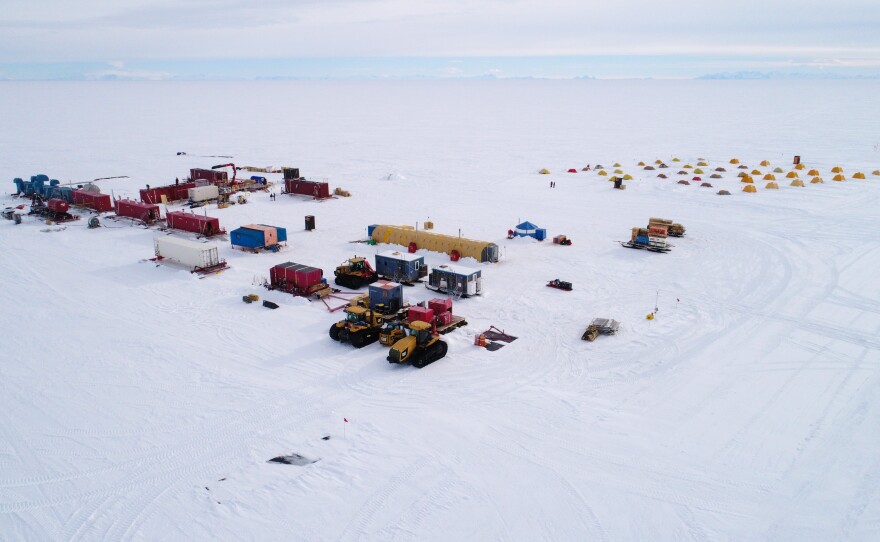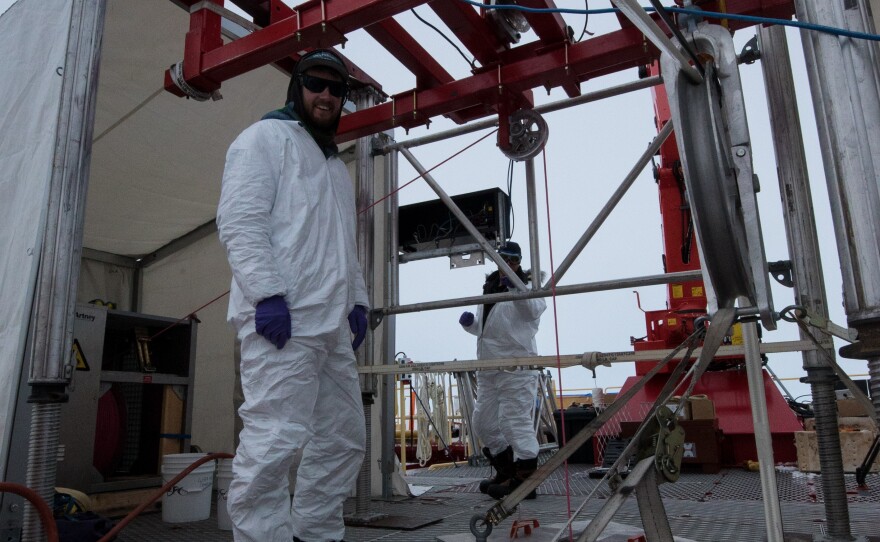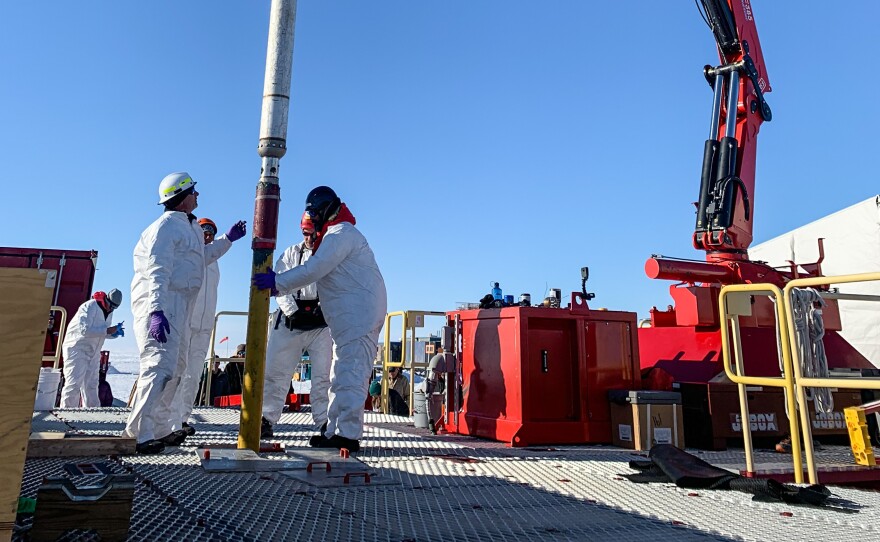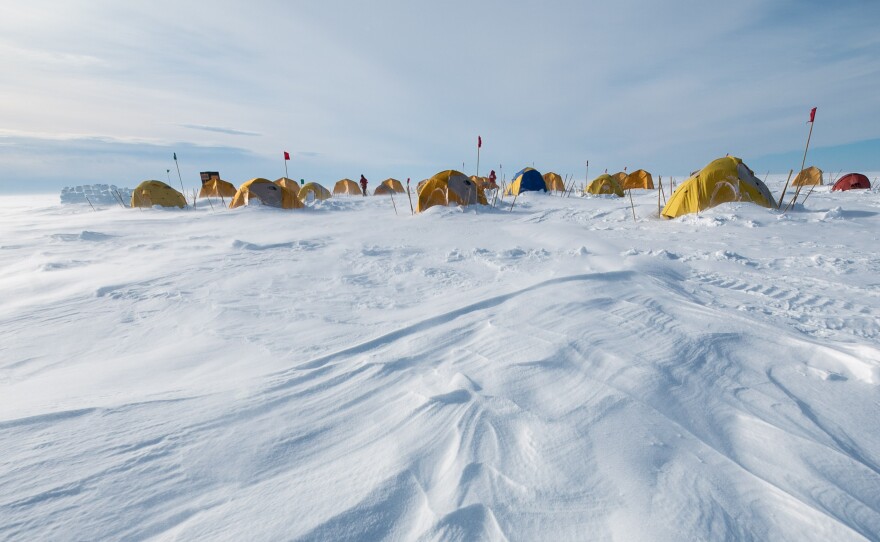A research project put together in part by San Diego researchers achieved something never before done.
The research team recovered lake-bed sediment samples, buried under a 15-meter-deep lake located under 3,500 feet of Antarctica ice.
The layered samples are the first of their kind collected on the massive continent.
It took researchers two seasons to travel across the cold barren landscape to reach Mercer Lake.
“It’s a little harder in Antarctica,” said Matthew Siegfried, a geologist at the Colorado School of Mines. “First of all there’s a big ice sheet above the lake that we’re interested in and then it’s far from pretty much everything. And so all of our logistics went through McMurdo Station which is about 500 miles from the lake we were interested in sampling.”

Siegfried was a graduate student at the Scripps Institution of Oceanography when he started working on the Subglacial Antarctic Lakes Scientific Access project with Scripps Glaciologist Helen Fricker.
Researchers did not know about active lakes under ice streams until about 2006, when Fricker discovered their existence using data from ICESat, NASA’s ice-measuring satellite. Those lakes regularly fill and drain, and researchers want to know more about those processes.
Siegfried said getting the proper scientific equipment above Mercer Lake required a monumental effort.
Tractors pulled enough gear over the ice to build a small village and set up a drill. However, that drill did not use a steel bit to bore through the ice.
Researchers melted ice around the camp, sterilized the water and heated it to 200 degrees.

“And we take a firehose of hot water,” Siegfried said. “Literally like a multi-inch diameter fire hose made of Kevlar, and we just point it into the ice and we go down.”
The scientists needed to be efficient because the hole they pierced in the ice sheet — 3,500 feet thick above Mercer Lake — began to freeze as soon as they cut it.
“When we accessed Mercer subglacial lake, the water column was about 15 meters thick, so that’s a pretty deep lake,” said Ryan Venturelli, a researcher at the Colorado School of Mines.
Long metal cylinders were dropped through the hole and into the lake. Gravity pulled the containers to the bottom where the device captured a sample on the lake floor.
Those samples had layers of sediment. Much like tree rings, the sediment layers reveal what has been happening in this hidden body of water. When it fills and when it drains.

“In this subglacial environment we have never seen something like this before,” Venturelli said. “But we have thought, since we initially observed these lakes underneath the ice sheet, that they should reflect something of the overlying ice.”
The entire expedition is chronicled in the Documentary: The Lake at the Bottom of the World, which was produced in 2022.
Previous scientific attempts to recover sediment cores from underwater lakes failed because the region they sampled got churned up by the ice above the water. This lake was different. It was deep and had a basin full of sediment.
“It’s a pancake,” Siegfried said. “ It’ll deposit one type of sediment. Then another layer goes on top of that that’ll be a different kind of sediment. And on and on we go. And that’s how we draw paleo climate conclusions every day in ocean cores for example.”
"We can put it into a model which predicts the future of the ice sheet which is what the data will eventually be able to inform."Helen Fricker, Scripps Institution of Oceanography
Those layers tell the story of the lake and the surrounding ice. And it tells a story which fills a gap in the scientific record.
Core samples from the ocean floor around Antarctica tell the geological history of the region. But only until about a thousand years ago.
Satellite imagery has a pretty good record of the past two decades.
These lake cores — extracted in this yearslong effort — could help fill the historical gap.

“It’s not only what is there, it’s how long has it been there, and it tells us a lot more about the process,” said Helen Fricker, a glaciologist at the Scripps Institution of Oceanography.
“It’s kind of a time scale problem. We’ve only sampled for a very small window. And we need to extend that backwards in time and to help us predict ... how things might change in the future,” Fricker said.
Fricker helped put together the effort to study the lake.
The sediment cores will allow researchers to record the history of a lake locked up under thousands of feet of ice. It will also help them understand the ice sheet above the water.
The continent holds more than 60% of the world’s fresh water, and it could become a major factor as sea levels rise on a warming planet.
“It’s basically subglacial hydrology, so we need to get that right in our models. It can help us constrain that process and help understand it better, so we can put it into a model which predicts the future of the ice sheet which is what the data will eventually be able to inform,” Fricker said.
Findings from the expedition are published in the March 9 edition of the journal Geology.









